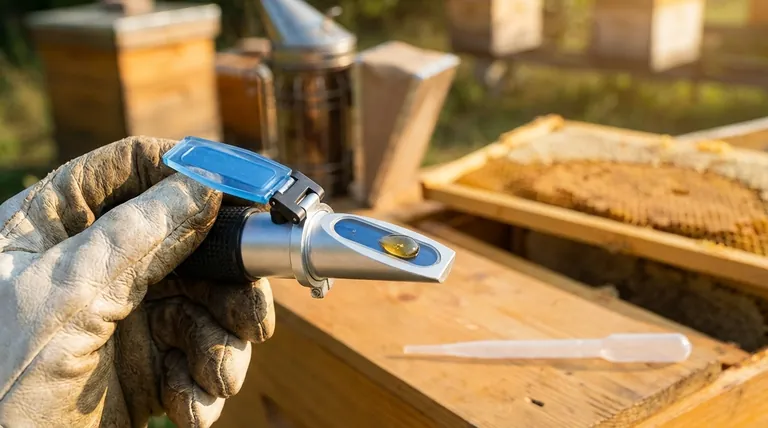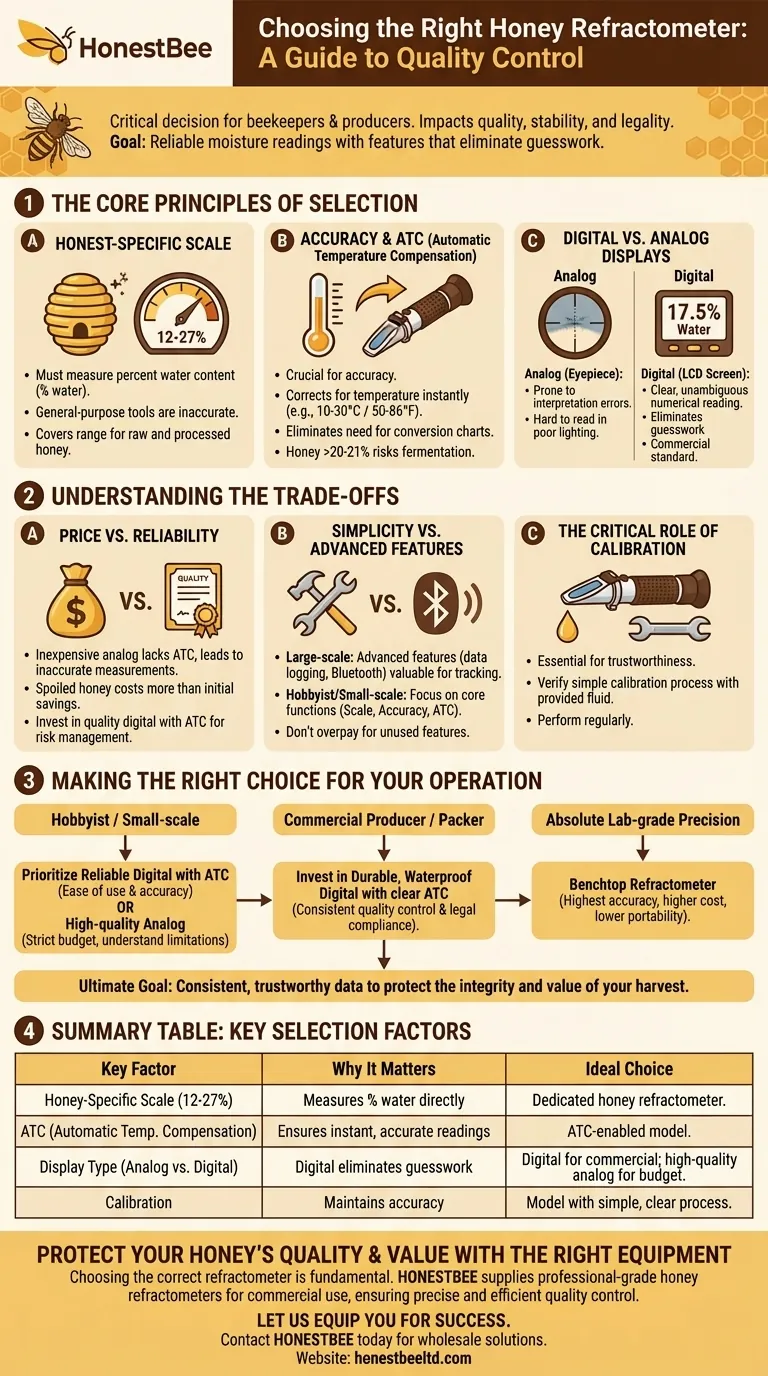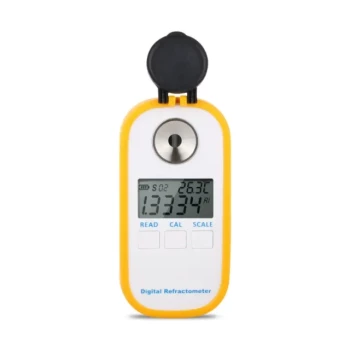Choosing the right honey refractometer is a critical decision for any beekeeper or producer, directly impacting the quality, stability, and legality of your final product. The most important factors to consider are ensuring the device has a dedicated honey moisture scale (typically 12-27%), includes Automatic Temperature Compensation (ATC) for accuracy, and offers a clear, easy-to-read display.
Your choice of a refractometer is not merely about purchasing a tool; it's about implementing a quality control system. The goal is to obtain reliably accurate moisture readings, with the key differentiators being the features that eliminate guesswork and user error, such as Automatic Temperature Compensation and a digital display.

The Core Principles of Selection
To make an informed choice, you must understand the foundational features that define a refractometer's performance. These components are not just specifications on a box; they are the mechanisms that ensure your honey is safe from fermentation and meets required standards.
The Non-Negotiable: A Honey-Specific Scale
A refractometer works by measuring the refractive index of a liquid, but this reading must be converted to a meaningful value. A general-purpose refractometer is not suitable.
You must select a device calibrated specifically for honey, which displays readings as percent water content (% water). This scale is typically in the range of 12% to 27%, which covers the full spectrum for raw and processed honey.
Accuracy and Automatic Temperature Compensation (ATC)
Accuracy is paramount. Honey with a moisture content above 20-21% is at high risk of fermentation, rendering it unusable. Your tool must be precise enough to measure this critical threshold.
Automatic Temperature Compensation (ATC) is arguably the single most important feature for achieving accuracy in real-world conditions. The temperature of the honey sample directly affects its refractive index.
Without ATC, you would need to wait for the honey and the device to equalize in temperature and use conversion charts to correct the reading. An ATC-enabled refractometer automatically adjusts for temperatures within a specified range (e.g., 50-86°F or 10-30°C), providing an accurate reading instantly.
Digital vs. Analog Displays
The display is where you interact with the data, making its clarity crucial. You have two primary options:
- Analog (Eyepiece): These traditional models require you to look through an eyepiece to see a dividing line on a printed scale. While often more affordable, they are prone to interpretation errors and can be difficult to read in poor lighting.
- Digital (LCD Screen): These devices provide a clear, unambiguous numerical reading on a screen. They eliminate user guesswork, are faster to use, and are the standard for any commercial or serious operation due to their consistency.
Understanding the Trade-offs
Choosing a refractometer involves balancing cost, features, and your specific operational needs. Understanding the compromises is key to avoiding buyer's remorse.
Price vs. Reliability
There is a direct correlation between price and reliability. Inexpensive analog models can seem like a bargain, but their lack of ATC or difficult-to-read scales can lead to inaccurate measurements.
A spoiled batch of honey due to a faulty reading will cost far more than the initial savings on a cheaper tool. Investing in a quality digital model with ATC is an investment in risk management.
Simplicity vs. Advanced Features
For large-scale commercial operations, advanced features like data logging or Bluetooth connectivity can be invaluable for tracking quality control across many batches.
However, for a hobbyist or small-scale beekeeper, these features are often unnecessary. The focus should remain on the core functions: a honey-specific scale, proven accuracy, and ATC. Do not overpay for features you will not use.
The Critical Role of Calibration
Even the most expensive refractometer is useless if it is not properly calibrated. Most units come with a calibration fluid or recommend using distilled water.
Before purchasing, verify that the device has a simple and clear calibration process. This procedure must be performed regularly to ensure your readings remain trustworthy.
Making the Right Choice for Your Operation
Select your tool based on the demands of your work. The goal is consistent, accurate data.
- If you are a hobbyist or small-scale beekeeper: Prioritize a reliable digital model with ATC for its ease of use and accuracy, or a high-quality analog model if you are on a strict budget and understand its limitations.
- If you are a commercial producer or packer: Invest in a durable, waterproof digital refractometer with clear ATC specifications to ensure consistent quality control and compliance with legal standards.
- If your primary goal is absolute lab-grade precision: Your needs may require a benchtop refractometer, which offers the highest level of accuracy but at a significantly higher cost and lower portability.
Ultimately, the right refractometer is the one that gives you consistent, trustworthy data to protect the integrity and value of your harvest.
Summary Table:
| Key Selection Factor | Why It Matters | Ideal Choice |
|---|---|---|
| Honey-Specific Scale (12-27%) | Measures % water content directly; general-purpose tools are inaccurate. | Dedicated honey refractometer. |
| Automatic Temperature Compensation (ATC) | Automatically corrects for temperature, ensuring instant, accurate readings. | ATC-enabled model (e.g., 10-30°C / 50-86°F range). |
| Display Type (Analog vs. Digital) | Digital LCD screens eliminate guesswork; analog eyepieces can be hard to read. | Digital for commercial use; high-quality analog for hobbyists on a budget. |
| Calibration | Regular calibration with provided fluid is essential for maintaining accuracy. | Model with a simple, clear calibration process. |
Protect Your Honey's Quality and Value with the Right Equipment
Choosing the correct refractometer is fundamental to maintaining the quality, stability, and marketability of your honey. For commercial apiaries and beekeeping equipment distributors, consistent and accurate moisture testing is non-negotiable.
HONESTBEE supplies professional-grade beekeeping supplies and equipment through wholesale-focused operations. We provide durable, reliable honey refractometers designed for the rigorous demands of commercial use, ensuring your quality control is precise and efficient.
Let us equip you for success. Contact HONESTBEE today to discuss your specific needs and discover how our wholesale solutions can support your operation's growth and integrity.
Visual Guide

Related Products
- Precision Honey Refractometer Instrument for Quality Assessment
- Digital Honey Refractometer for Precision Measurement of Optimal Honey Quality
- HONESTBEE 72 Frame Industrial Electric Honey Extractor for Beekeeping
- 6 Frame Manual Stainless Steel Honey Extractor Beekeeping Equipment
- Plastic Hand Crank 2 Frame Honey Extractor Low Price
People Also Ask
- What are the key points for proper usage of a honey refractometer? Ensure Accurate Moisture Readings Every Time
- Why is a honey refractometer important for beekeepers? Ensure Quality and Prevent Fermentation
- What are the key steps to using a honey refractometer? Ensure Honey Quality & Prevent Fermentation
- What are the benefits of using a Pocket Digital Honey Refractometer? Achieve Precision & Speed in Honey Quality Control
- Why is a honey refractometer considered essential for commercial beekeepers? Ensure Honey Quality and Profitability



















